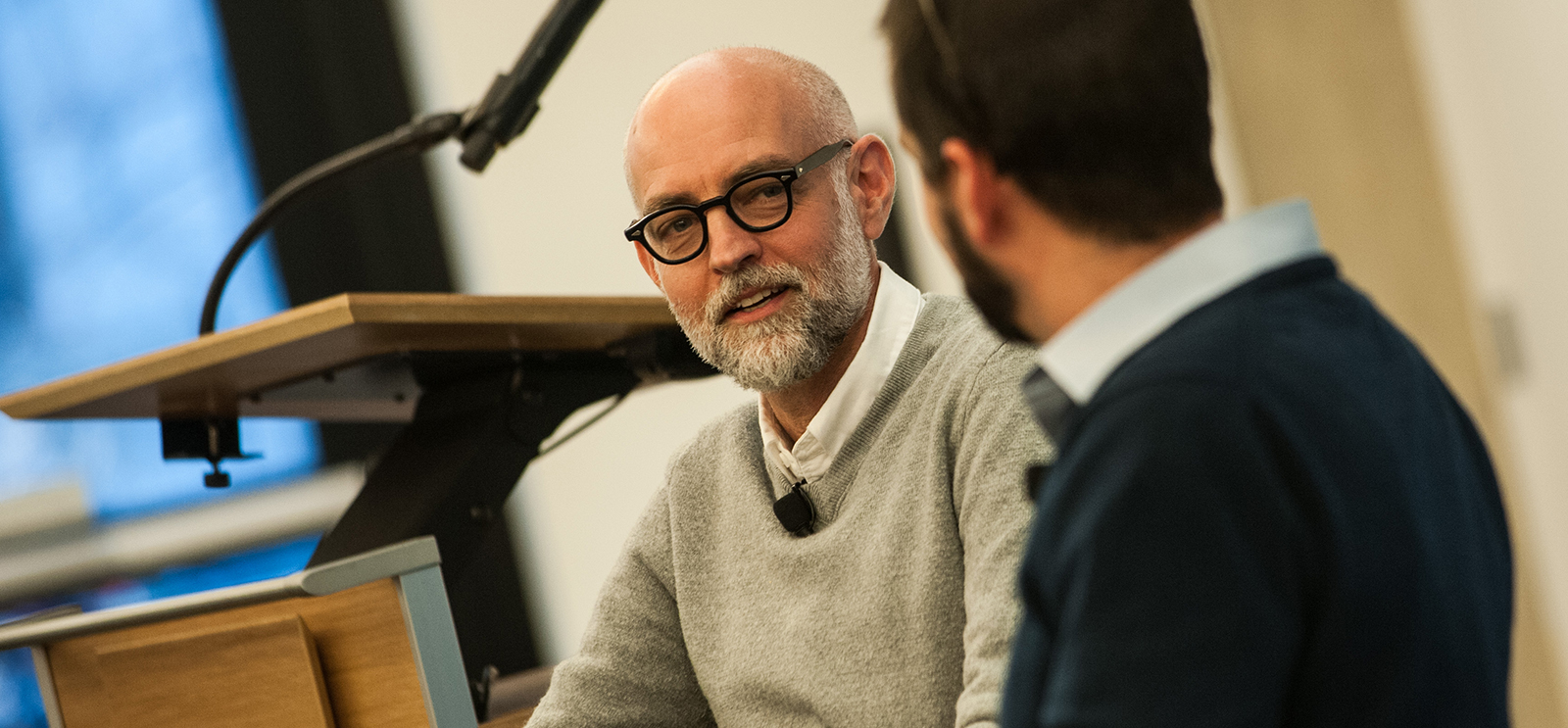
Artist Daniel Clowes (left) talks with lecturer Daniel Raeburn (right) at the March 29 event. (Photo by Jean Lachat)
The Ghost World author and Hyde Park native opens up about his creative process.
“I grew up blocks from this very space,” cartoonist Daniel Clowes, LAB’79, told the crowd gathered at the Regenstein Library. Clowes now lives in Oakland, California, but to this day, Hyde Park’s street names float through his dreams. “When I wake up, I still think I’m in ninth grade and I have to walk down Woodlawn Avenue to school.”
The March 29 event, held in honor of the opening of an exhibition of Clowes’s work in the Special Collections Research Center closed a circle that began in childhood, when the University of Chicago, “both the campus and the institution, was central, almost overwhelmingly so, to my formative life,” Clowes has said.
[[{"type":"media","view_mode":"media_original","fid":"3435","attributes":{"alt":"","class":"media-image","height":"333","typeof":"foaf:Image","width":"500"}}]]Self-portrait sketch for Mister Wonderful, ca. 2008–11. (Daniel Clowes Archive, University of Chicago Library. Copyright Daniel Clowes.)
Clowes’s parents, an auto mechanic and a furniture craftsman, divorced when he was two, and he spent much of his time with his grandparents. His grandfather, James Lea Cate, PhD’35, was a scholar of medieval history and historiography. (His stepmother, Harriet Clowes, also had University ties; she worked in development at the University of Chicago Library in the late 1970s.) Clowes’s papers—from which the exhibition is drawn—are held in the Library’s archives, alongside his grandfather’s.
The hometown-boy-done-good, known for his oddball, loner characters and eclectic visual style, is widely considered one of the most important cartoonists of his generation. Clowes’s new graphic novel, Patience (Fantagraphics, 2016), is earning raves, with reviewers calling it “stunning” and “Clowes’ most confident and clear-headed book to date.”
During a free-flowing conversation with Daniel Raeburn, lecturer in creative writing at UChicago, Clowes revealed the painstaking creative process behind his comics. He begins with outlines and sketches before moving to illustration (“I always just wanted to draw—that was my goal all along”), laborious hand lettering (“a slog”), and coloring (in the case of Patience, “a full year of living hell ... at the end of the year I was literally having dreams in Photoshop”).
[[{"type":"media","view_mode":"media_original","fid":"3436","attributes":{"alt":"","class":"media-image","height":"333","typeof":"foaf:Image","width":"500"}}]]Character sketches for The Death-Ray, ca. 2003–11. (Daniel Clowes Archive, University of Chicago Library. Copyright Daniel Clowes.)
Through it all, Clowes said, he hopes to create a holistic and intimate experience for readers on each page. “It has to all be me. I can’t allow any other input,” he explained. That’s why he eschews computerized fonts. “There would be some slight input from a machine or a programmer in Silicon Valley. To me, it’s about getting the essential, the personal onto that page.”
Clowes was always attracted to comics. “I read them all,” he said. In his teens, he consumed the lowbrow, the highbrow, and every brow in between, but he soon developed a more critical eye: “I realized at 18 I didn’t need to read Richie Rich anymore.”
In art school, Clowes was disappointed to discover his instructors’ disdain for the medium of comics—and its practitioners, whom they dismissed as “weirdos and degenerates … with no other source of potential income.”
Yet he’s never been able to abandon the medium. In his attempts at writing fiction, “when I sit down to describe a character’s room, I think, ‘I could just draw a picture of it.’”
Comics remain, in Clowes’s eyes, a medium that facilitates “the perfect one-to-one relationship from an artist to a reader,” both created and consumed alone. “Where else in the world do you have complete control?”
